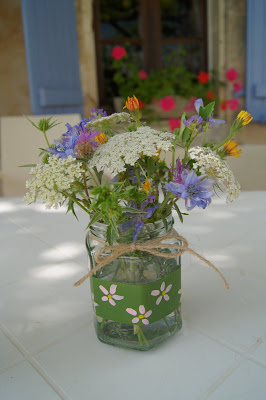Here I am on the way to the Nether Edge Farmers’ Market in Sheffield. It took place yesterday, Sunday 25 September. I am carrying a crate of posies and a jug with a couple of bunches of flowers in it. Let me start by telling you about the arrangements that I created. All of these used flowers from English growers, together with some flowers and foliage from our own garden. I made a few large bouquets, using two different colour ways (I used broadly the same colours for all of the arrangements) and presented them in aqua packs in boxy green bags. These were the premium product! The first is based mostly on pinks/blues and purple, and the second is based on autumnal colours – mainly yellow and orange/brown.
Then I made several smaller hand-tied bunches which I finished off with a piece of pretty lace tied with some string. Here is one based on the yellow theme.
My main product was a range of small posies presented either in hand decorated jars or in up-cycled tins. I also made a few edible posies using borage and herbs from our garden. Here is an example of a posy in an up-cycled tin.
Then I had fantastic help from Jessie (my daughter) who designed the lettering for Meadowsweet and the little sprig of meadowsweet which sits alongside the name. She had special stamps made so that we could stamp the meadowsweet identity on to tags (which also acted as business cards) and bags of all sizes. I was really pleased with the way this simple method complemented the natural approach that I am taking to my work with flowers.
I shared the stall with my friend, Ann, who makes hand thrown ceramics – really lovely individual pieces in lots of different vibrant colours. The flowers and the ceramics really worked well together. Here we are at the start of the market behind our stall waiting for action to commence.
The whole market had a great vibe. It was full of interesting stalls – rustic bread, wild mushrooms, organic burgers, whole fresh trout, olives, cupcakes, crafts, plants and many more. It was at the centre of the Nether Edge community and was really well attended, even though the weather wasn`t great. Lots of people stopped to talk to us about our wares. They seemed to like my use of flowers – especially the focus on English flowers. They liked the pink/blue/purple colour way most and the best sellers were the posies in the hand decorated jars. This is a close up of some of the posies on the stall.
And here are Jessie and Anne later in the day with our stocks somewhat depleted. Anne and I were both pleased with the amount we sold and the positive response we received from the market customers.
The tags which Jessie made sat on the front of the stall. Many of these were picked up as people passed by and then dropped into handbags. They give details of how to contact me and what I am offering – market stalls, arrangements for parties and events and flower workshops. This was the first step in promoting my new business. It was a great experience overall and I am looking forward to running another stall in the run up to Christmas.



















